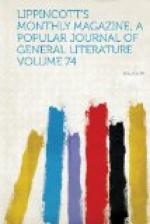First enters a line of gentlemen bearing long sticks. Behind them come the princesses, bowing on each hand. The princess of Wales advances first, with a naive, faltering, hesitating step, a strange and quite delicious blending of timidity and child-like confidence in her manner. Then come, walking by twos, some daughters of the queen. Then approaches the princess of Teck (Mary of Cambridge), a large and very jolly-looking person, with vast good-nature and a profuse smile, which she seems to throw all over everybody. A German duchess or two follow her. The curtsies of these German princesses are indeed quite wonderful. After entering the hall one of them will espy (such, I suppose, is the fiction) some persons to whom she wishes to bow, and she then proceeds to execute a performance of some minutes’ duration. Before curtsying, she stops and seems to “shy,” and looks at the ladies as a frightened horse examines intently the object which alarms him: she then sinks slowly backward almost to the ground, and recovers herself with the same slowness. It would seem that such a genuflection must be, of necessity, ridiculous. But it is not so in the least: it is quite successful, and rather pleasing. After the ladies come the prince of Wales and his suite. The royalties then all go upon the stage, and after music the ball begins.
There are two sets of dancers. The princes and princesses open the ball with the diplomatists and some of the highest nobility on the space just in front of the dais. The rest of the hall is occupied by the other dancers, who later in the evening find their way into the diplomatic set. The dancing in the quadrilles and Lancers is of a rather stately and ceremonious sort. In waltz or galop the English always dance the same step, the deux temps, and the aim of the dancing couple is to go as much like a spinning-top as possible. They make occasional efforts to introduce puzzling novelties like the trois temps, the Boston dip, etc., but, I am glad to say, without any success. The result is, that once having learned to dance in England, you are safe.
The great hall during the waltz is a brilliant spectacle. There are many beautiful women, the toilets are dazzling, and all the men are “flaming in purple and gold.” There is every variety of magnificent dress. Officers of a Russian body-guard are gold from head to foot. Hungarians wear purple and fur-trimmed robes of dark crimson of the utmost splendor. The young men of the Guards’ clubs in gold and scarlet coats, and in spurred boots which reach above their knees, clank through the halls. Scotch lords sit about, and exhibit legs of which they are justly proud. Here, with swinging gait, wanders the queen’s piper, a sort of poet-laureate of the bagpipes, arrayed in plaid and carrying upon his arm the soft, enchanting instrument to the music of which, no doubt, the queen herself dances. The music of the orchestra is perfect, and he must be a dull man who does not feel the festivity, the buoyancy and the elation of the scene.




